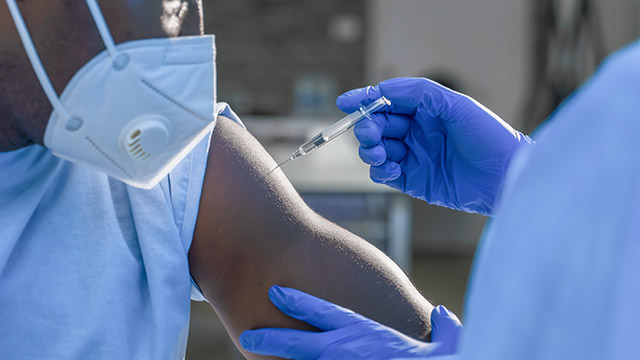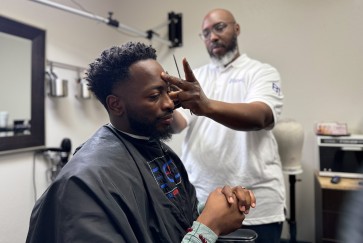It can start to feel exhausting, if not impossible, to keep up with the ever-evolving news about COVID-19 and the vaccine rollout.
How many vaccines are in production? Which ones are most effective and does that even matter? When will I be allowed to get one? What is herd immunity and will we be able to achieve that? Will this pandemic ever be officially over?
All good questions. Here are answers from Northwestern University Feinberg School of Medicine experts who have been dedicated to fighting the virus since it began spreading.
Should we weigh the pros and cons of each vaccine before getting the shot?
Dr. Elizabeth McNally is a Northwestern Medicine cardiologist and geneticist who has been screening Chicagoans for COVID-19 antibodies since March 2020.
“No, I think you should take the first thing that’s available to you. Stop thinking. Just say yes and do it. Don’t hesitate. What’s going to make this work right now is vaccinating as many people as quickly as we possibly can. This is a giant, giant forest fire and you have to just start putting out the fire in all these places. It’s going to have little pop-up fires and we’re going to have to beat them down again."
What are the risks or side effects associated with the vaccine?
Dr. Gary Noskin is a Northwestern Medicine infectious diseases specialist who has been instrumental in leading Northwestern Medicine’s health system response to COVID-19.
“The side effects following vaccination represent immune system activation so when you develop symptoms, it suggests your immune system is responding properly to the vaccine. When I got my vaccine and I developed a little soreness at the injection site, fatigue and low-grade fever, I thought, ‘This is great. My immune system is working, I’m going to be protected against this novel coronavirus.’ I think it’s important that we message the most common side effects reflect a functioning immune system.”
In addition to the Pfizer and Moderna vaccines, what others are coming?
Dr. Robert Murphy is the executive director of Feinberg’s Institute for Global Health who helped form Northwestern’s COVID-19 Vaccine Communication and Evaluation Network (CoVAXCEN).
“There are at least nine covid-19 vaccines approved worldwide including those from Pfizer and Moderna, with an additional 54 in clinical development and 87 more still in the animal testing stage. The next approval in the U.S. will most likely be the Johnson & Johnson AD26.COV2.S vaccine, which is expected to receive Emergency Use Authorization (EUA) as early as February 2021. The Johnson & Johnson vaccine does not have as strict storage requirements as the others and may only require one dose. The Astra-Zeneca vaccine is approved in the UK, but there are still dosing and efficacy questions. The next one likely to be approved is from Novavax, with EUA approval expected sometime in the first quarter of 2021. By the middle of the 2021, there are going to be a half a dozen companies with vaccine that are scaled up and distributing vaccines. With the Defense Production Act now invoked, vaccine production is going to be even greater. The supply problem is short term; long term, there will be billions of doses.”
What should public health officials be doing to fight vaccine hesitancy?
Robert Murphy: “We all have to get on the same page. We have had basically one year of significant mixed messaging on coronavirus-19 transmission and the pathway to achieving herd immunity. The messaging for the vaccines I believe has been greatly undersold. Success rates of 95% are much higher than originally thought. The incredible rate of vaccine development has been interpreted by some to suggest that corners were cut and safety compromised, which is not true. To make matters worse, the vaccine rollout is behind and distribution to the states and territories has been nothing short of chaotic. All of that has to be straightened out and information must be transparent and clear.
“On the first day of new administration, the United States re-engaged with the World Health Organization (WHO) and we rejoined the community of nations fighting the pandemic together. Hopefully we can work together to vaccinate all the people in the world, which is for everyone’s benefit, because if we neglect anyone on the planet, we will never rid ourselves of this virus. It’s too small of a world now, the whole world has to be vaccinated.”
How do we get ‘more needles in arms’ more quickly and effectively?
Gary Noskin: “In the 1950s, the polio vaccination rate among children was initially 0.6 percent. And then Elvis went on The Ed Sullivan Show and got vaccinated live, and the vaccination rate went from 0.6% to 80%. So we need to figure out the 2021 version of Ed Sullivan and Elvis.”
Do you worry about the virus’ mutations? Will the vaccines protect against them?
Robert Murphy: “I am very worried about the mutations. The current B.1.1.7 variant of SARS-CoV-2 actually has 23 mutations – eight of them on the spike protein itself, and is associated with more rapid transmission. Other variants may actually be more lethal. The encouraging news is that the current vaccines and antibody therapies should work on this set of variants, however SARS-CoV-2 will keep mutating until we get it suppressed. The more virus out there replicating, the more it will mutate. The next mutation could be much more dangerous.”
Elizabeth McNally: “I think the vaccines will still be reasonably protective against these new versions of the virus, and thankfully, this isn’t a really fast-mutating virus compared to some other ones. Viruses mutate; that’s what they do, and the perfect setup for generating more mutations in the virus is to have so many people infected with it. This just comes back to what we keep saying. The best defense against this right now is to get as many people vaccinated as quickly as we can. Let’s start putting the fire out.”
When will we be able to travel, meet together in person, go to an indoor restaurant?
Gary Noskin: “Initially, the estimates that I made were based on an expectation that we would have vaccinated 20 million people by the end of December, which wasn’t the case. We’ve vaccinated about four million. We’re about 20 percent of what we expected, so a lot of it is going to be dependent on how long it takes us to receive and achieve herd immunity — a concept in which somewhere between 70% and 80% of the individuals have either been vaccinated or have had a natural infection, which is about 230 million people. Based on the vaccine rollout, I’m thinking that’s going to be sometime in the Fall, perhaps October or November, but that’s assuming people get vaccinated, that we don’t see any mutant viruses that evade the vaccine and that the vaccine protection lasts as long as we expect. If that’s the case, it will be very successful. So I’m thinking sometime in the fall of 2021.”
What was the thought process behind the phased vaccine rollout?
Elizabeth McNally: “Part of the strategy of why they wanted healthcare providers to get the vaccine first is 1) to protect healthcare providers so we have enough healthcare providers and 2) so we could tell people what the experience is. The answer is that getting vaccinated was no big deal. It meant a lot this week and last when I could tell my patients in clinic that, ‘Hey, I did it, it was fine and I didn’t have a problem.’
“To be bluntly practical, the reason we’re vaccinating older people sooner than others is to keep them from filling up the ICU beds. That’s always been what the strategy of minimizing our interactions has always been about. There were some that suggested we should just let COVID run wild to let the population build up immunity. The flaw in that thinking is that we only have about a million hospital beds in total in this country and we only have about 55,000 to 60,000 ICU beds, and most of the time, hospitals and ICUs operate pretty full. So we don’t have a system that can handle so many more patients needing beds and ICU beds. So this approach would kill a lot of people and also results in deaths beyond the people with COVID because they can’t access the healthcare system. So our steps right now have to be about preserving a functional healthcare system.”


